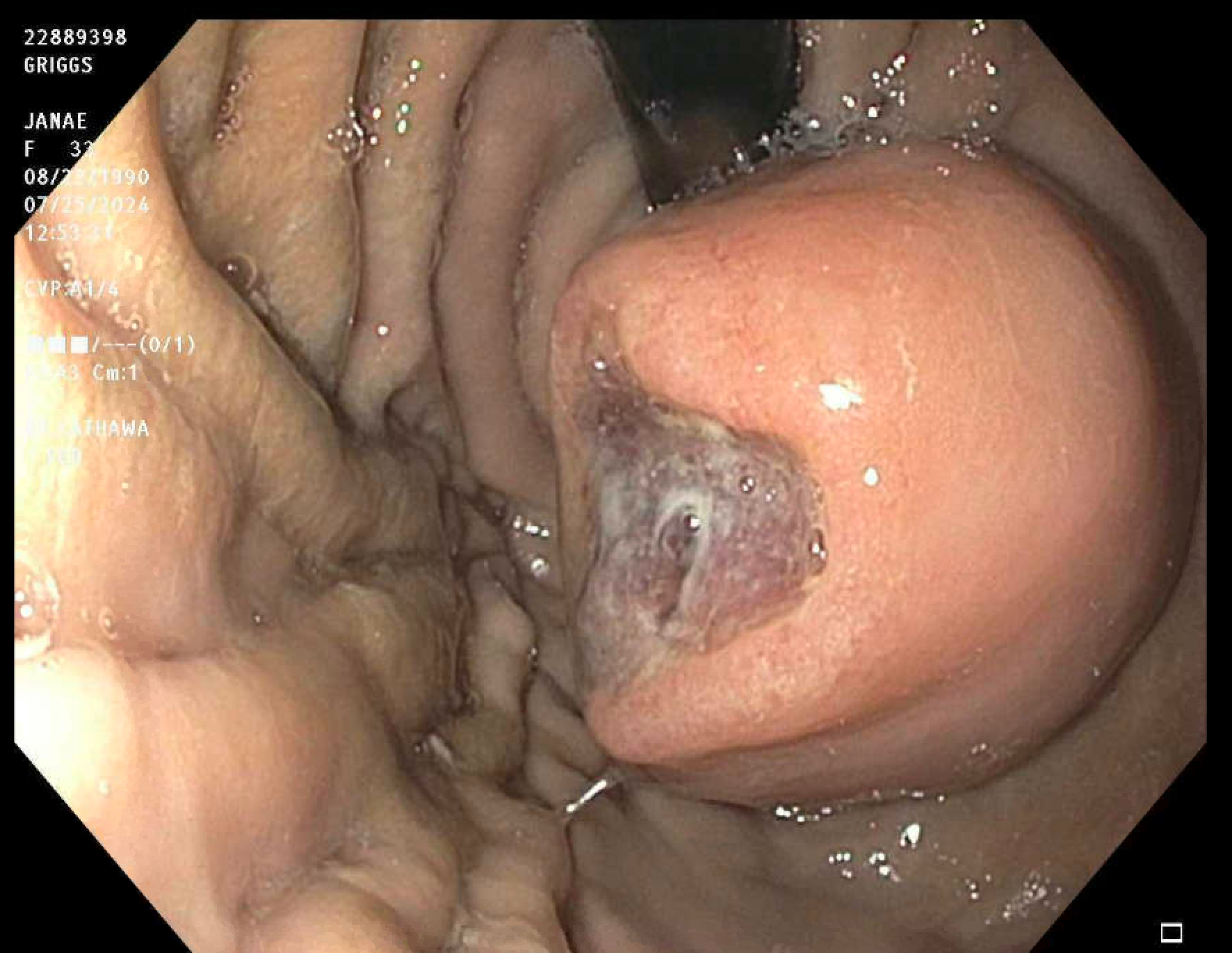Tuesday Poster Session
Category: General Endoscopy
P5168 - An Atypical Presentation of a Newly Found GIST Tumor
Tuesday, October 28, 2025
10:30 AM - 4:00 PM PDT
Location: Exhibit Hall

George Darany, DO, MBA (he/him/his)
Corewell Health
Farmington Hills, MI
Presenting Author(s)
Jolian Kathawa, DO, Hussein Bazzy, DO, George Darany, DO, MBA, Kholood Elhaj, DO
Corewell Health, Farmington Hills, MI
Introduction:
Introduction:
Gastrointestinal stromal tumors are a type of sarcoma that arises from the interstitial cells of Cajal and are most commonly secondary to KIT or PDGFR gene mutations. They account for approximately 0.1-3% of total gastrointestinal malignant tumors each year, while ranging from a few millimeters to 30 centimeters. Due to their function as pacemaker cells of the GI tract, more than 50% arise in the stomach. Several factors including size, location, and its miotic rate contribute to its likelihood to metastasize. Further diagnosis through CT/MRI imaging or upper endoscopy/colonoscopy are crucial to treatment options. Depending on location and type of mutation, Imatinib has been used for first-line treatment and frequently in conjunction with surgical resection.
Case Description/
Methods:
Case Description:
A 33 year-old female with past medical history of iron-deficiency anemia presented with chief complaint of hematemesis with one large clot along with associated abdominal pain. Patient was found to have a hemoglobin of 5.5 upon admission with improvement to approximately 7.5 despite transfusion with 5 units of packed red blood cells. Additionally, she was found to have a right segmental pulmonary embolus which required IVC filter placement. She underwent an EGD which revealed a single ulcerated mass approximately 2cm from the GE junction, which biopsy later confirmed to be a low-grade GIST, spindle cell type. Patient was re-evaluated at a tertiary care center by Thoracic Surgery, which due to its relative location and responsiveness to therapy opted to treat with Imatinib to reduce tumor size before surgical resection. She was cleared by Hematology & Oncology for anti-coagulation upon discharge, however, re-presented to her primary care physician due to abdominal pain. Patient was found to be 8 weeks pregnant and due to currently receiving anti-coagulation along with Imatinib treatment she chose to terminate the pregnancy.
Discussion:
Discussion:
Although the mitotic count was less than 5 per 5mm, due to the location and size of the GIST in the patient first-line treatment with Imatinib was preferred. Only tumor sizes greater than 10cm in the stomach would be classified as moderate to high risk. Additionally, Imatinib is utilized due to only approximately 85% of patients result in complete resection with one half of them developing recurrence. Adjuvant Imatinib with surgical resection has been proven to be beneficial in patients with an intermediate or high risk of reoccurrence.

Figure: Endoscopic visualization of GIST tumor.
Disclosures:
Jolian Kathawa indicated no relevant financial relationships.
Hussein Bazzy indicated no relevant financial relationships.
George Darany indicated no relevant financial relationships.
Kholood Elhaj indicated no relevant financial relationships.
Jolian Kathawa, DO, Hussein Bazzy, DO, George Darany, DO, MBA, Kholood Elhaj, DO. P5168 - An Atypical Presentation of a Newly Found GIST Tumor, ACG 2025 Annual Scientific Meeting Abstracts. Phoenix, AZ: American College of Gastroenterology.
Corewell Health, Farmington Hills, MI
Introduction:
Introduction:
Gastrointestinal stromal tumors are a type of sarcoma that arises from the interstitial cells of Cajal and are most commonly secondary to KIT or PDGFR gene mutations. They account for approximately 0.1-3% of total gastrointestinal malignant tumors each year, while ranging from a few millimeters to 30 centimeters. Due to their function as pacemaker cells of the GI tract, more than 50% arise in the stomach. Several factors including size, location, and its miotic rate contribute to its likelihood to metastasize. Further diagnosis through CT/MRI imaging or upper endoscopy/colonoscopy are crucial to treatment options. Depending on location and type of mutation, Imatinib has been used for first-line treatment and frequently in conjunction with surgical resection.
Case Description/
Methods:
Case Description:
A 33 year-old female with past medical history of iron-deficiency anemia presented with chief complaint of hematemesis with one large clot along with associated abdominal pain. Patient was found to have a hemoglobin of 5.5 upon admission with improvement to approximately 7.5 despite transfusion with 5 units of packed red blood cells. Additionally, she was found to have a right segmental pulmonary embolus which required IVC filter placement. She underwent an EGD which revealed a single ulcerated mass approximately 2cm from the GE junction, which biopsy later confirmed to be a low-grade GIST, spindle cell type. Patient was re-evaluated at a tertiary care center by Thoracic Surgery, which due to its relative location and responsiveness to therapy opted to treat with Imatinib to reduce tumor size before surgical resection. She was cleared by Hematology & Oncology for anti-coagulation upon discharge, however, re-presented to her primary care physician due to abdominal pain. Patient was found to be 8 weeks pregnant and due to currently receiving anti-coagulation along with Imatinib treatment she chose to terminate the pregnancy.
Discussion:
Discussion:
Although the mitotic count was less than 5 per 5mm, due to the location and size of the GIST in the patient first-line treatment with Imatinib was preferred. Only tumor sizes greater than 10cm in the stomach would be classified as moderate to high risk. Additionally, Imatinib is utilized due to only approximately 85% of patients result in complete resection with one half of them developing recurrence. Adjuvant Imatinib with surgical resection has been proven to be beneficial in patients with an intermediate or high risk of reoccurrence.

Figure: Endoscopic visualization of GIST tumor.
Disclosures:
Jolian Kathawa indicated no relevant financial relationships.
Hussein Bazzy indicated no relevant financial relationships.
George Darany indicated no relevant financial relationships.
Kholood Elhaj indicated no relevant financial relationships.
Jolian Kathawa, DO, Hussein Bazzy, DO, George Darany, DO, MBA, Kholood Elhaj, DO. P5168 - An Atypical Presentation of a Newly Found GIST Tumor, ACG 2025 Annual Scientific Meeting Abstracts. Phoenix, AZ: American College of Gastroenterology.
